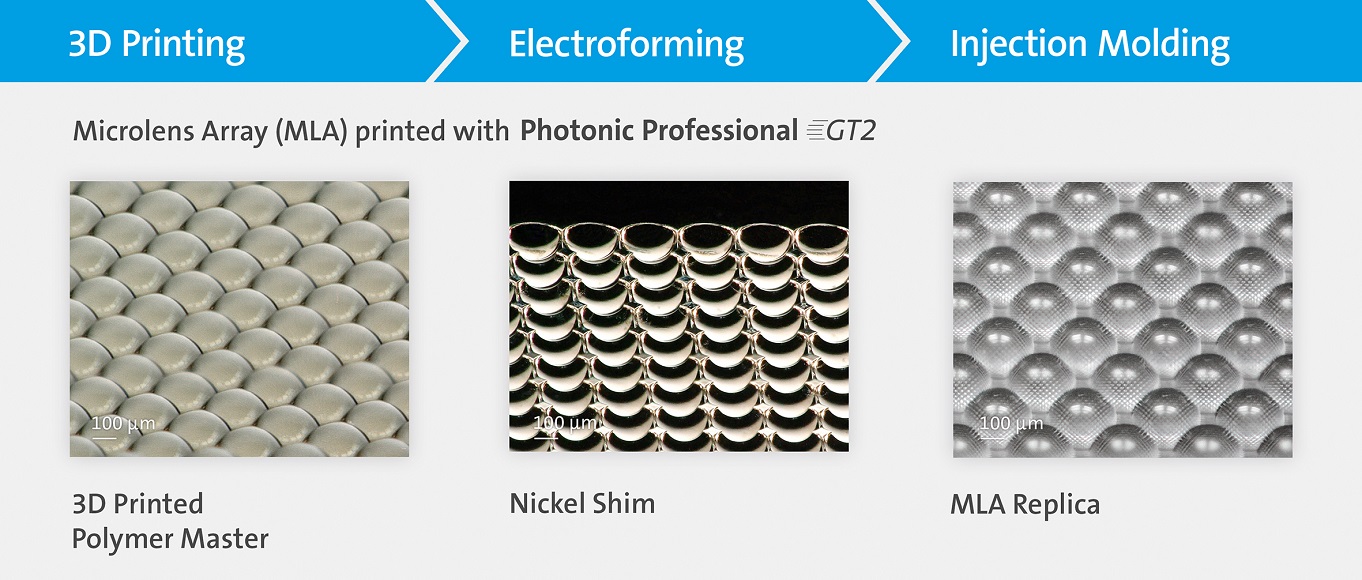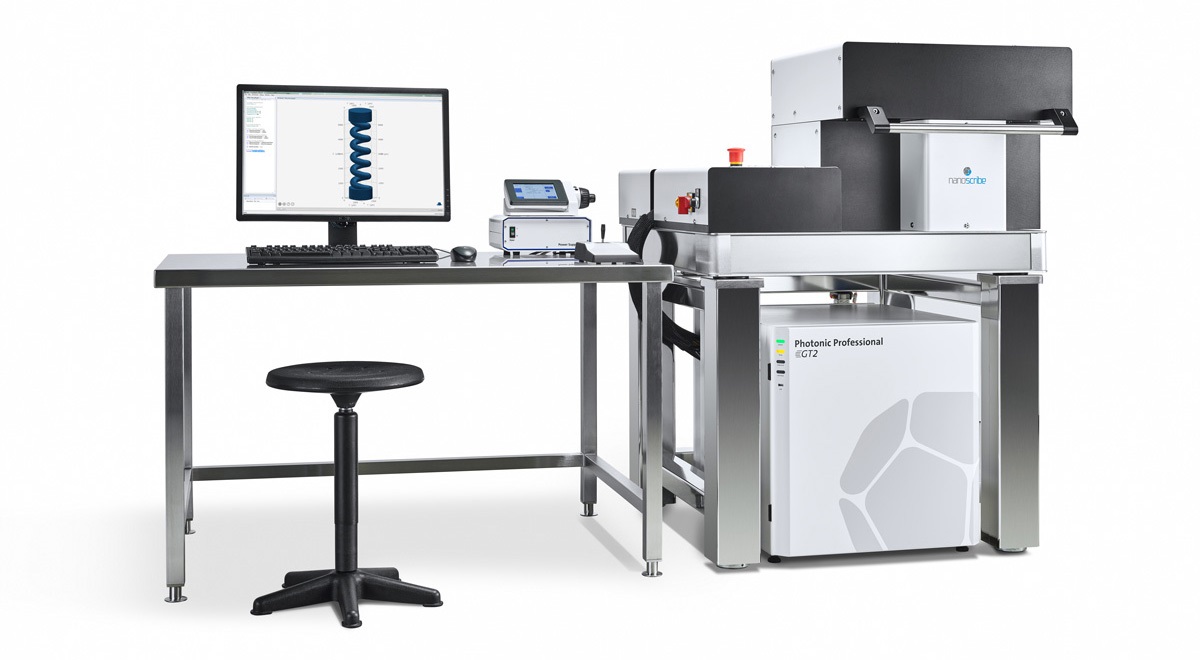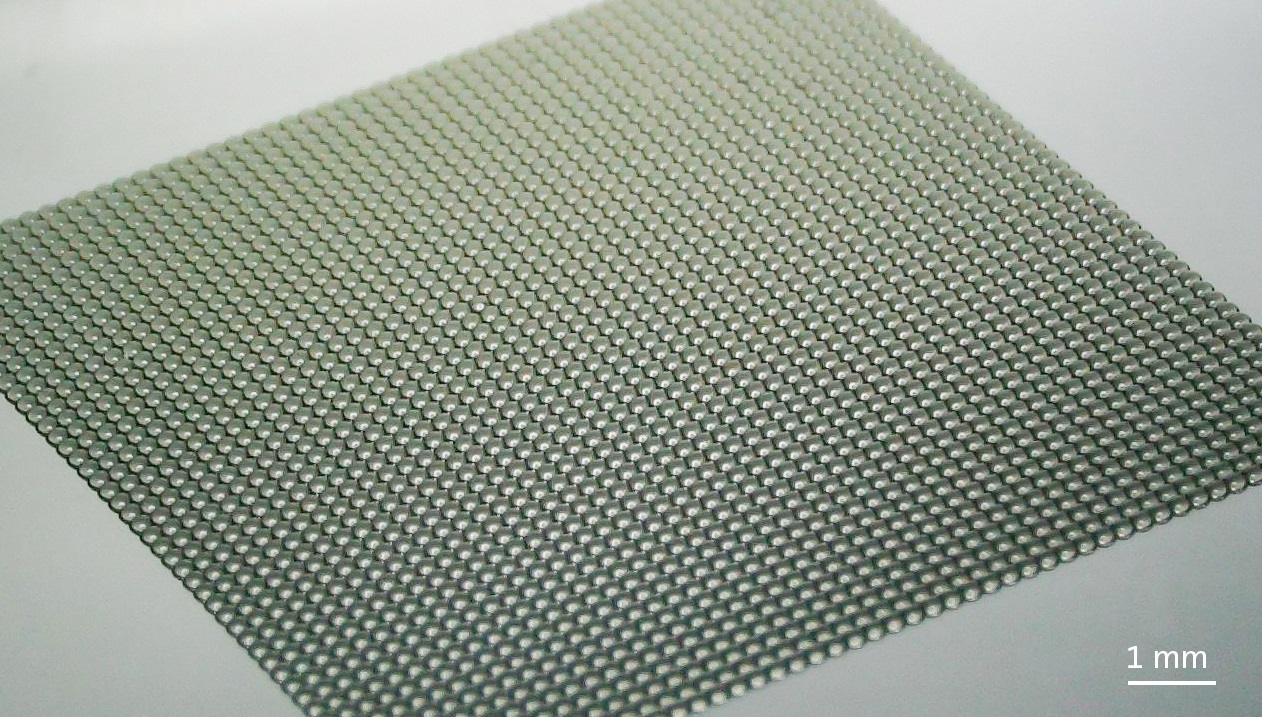February 4, 2019
Eggenstein-Leopoldshafen/ San Francisco Nanoscribe’s new Photonic Professional GT2 3D printers change the way to produce micro-optical components. This additive manufacturing technology enables the fabrication of ultra-precise micro-optics as polymer masters for serial production, which are needed, for instance, in mobile or augmented reality devices, for sophisticated sensors or advanced solutions in healthcare and automotive industry.
At the upcoming SPIE Photonics West, the leading trade fair in optics and photonics, Nanoscribe presents the entire process chain for series production of micro-optics based on 3D printed polymer masters as starting point (booth 366, South Hall). Up to now, the production of innovative micro-optical designs has been challenging due to very high demands with respect to shape accuracy and low surface roughness required for optimum optical performance. Furthermore, product development processes have to cope with the ever-increasing importance of rapid innovation cycles and low costs for serial production.
Serial Production by Injection Molding

The production process of microlens arrays, based on a 2PP printed polymer master and subsequent replication processes. The figure shows the process steps for injection molding.
The 3D printed polymer masters fit well into common industrial processes for series production such as injection molding, hot embossing and nanoimprint lithography. For example, a nickel shim is generated by electroforming the 3D printed polymer master of a microlens array. The shim is then used as an insert for injection molding of a thermoplastic polymer, such as PMMA (polymethyl methacrylate) or PC (polycarbonate). Within seconds the molten thermoplastic is injected into the insert cavity, cooled and solidified, duplicating the polymer master shape. This standard process cuts the production time and costs per piece to affordable consumer market products. Other techniques include replication by UV molding of a photosensitive material from PDMS (polydimethylsiloxane) negative stamps. At the upcoming SPIE Photonics West 2019, Nanoscribe presents the replicating production chain of micro-optics by means of injection molding and UV molding.
Additive Manufacturing of Micro-Optics

Photonic Professional GT2: Nanoscribe’s new 3D printer for the fabrication of ultra-precise prototypes and polymer masters for replication processes in micro-optics and diverse applications.
Based on the powerful technology of two-photon polymerization (2PP) Nanoscribe's 3D printers transform digital models directly into physical objects with submicron resolution. In comparison to conventional methods, such as gray-scale lithography, reflow techniques or diamond milling, Nanoscribe's 3D printers provide enormous freedom of design and at the same time a very robust chemical process to produce almost any concave or convex surface shape. Compact refractive optics, such as corner cubes with sharp edges, freeform optics and even compound lens systems of two or more stacked lenses have been produced with this technology. The straightforward workflow from a CAD model to the final 3D printed part contributes to direct and fast design optimization, shortening the product design iteration cycles. Also, multilevel diffractive optical elements with submicron resolution benefit from the one-step printing process that speeds up prototyping and polymer master fabrication at reduced costs, e.g. omitting several lithography steps and mask making.
The high precision 3D printer uses a femtosecond laser beam that exposes and solidifies photosensitive material only in the tight focal point. The printer scans the laser focus within a photoresin in a layer-by-layer fashion with layer distances down to the nanometer scale, creating 3D objects with optical surface quality in a single printing step. The additive process enables the fabrication of micro-optics with designs that are otherwise impossible to produce. Hemispherical and aspherical microlens arrays, for instance, can be fabricated with arbitrarily small distances between the lenses allowing even to overlap the lenses. Furthermore, they show smooth surfaces with a surface roughness of just a few nanometers and a shape accuracy of less than one micrometer. Both regular or computer-designed random lens arrangements can benefit from additive manufacturing, for example, in homogenizer applications required for illumination purposes.
The combination of Nanoscribe's advanced processes, software recipes with optimized print parameters and tailor-made 2PP resins is a key advantage for the direct fabrication of high-precision micro-optics, overcoming geometrical constraints known from standard fabrication methods and achieving high shape accuracy and optical smooth surfaces.















